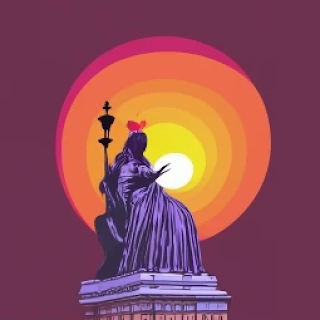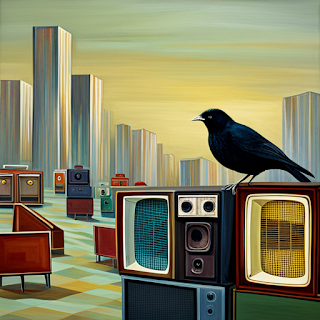Notes & Queries response: Why do Americans use the term ‘Victorian’?
 |
| image generated by Craiyon |
In fact, the star had been visible in the skies since the mid-1700s, with many ship's captains making mention of it in their logbooks. A century before, members of various First Nation tribes had noticed it as a faint, troubling presence in the Southern Hemisphere. These indigenous peoples are known for their keen visual intelligence. A particular arrangement of genes that broadens the optical spectrum is commonplace in their ancestry.
The Welsh stargazer and alchemist, Eifion Rowles, was as far as we know, the first to study the celestial interloper. He had noticed it from the arm of his plough. In a journal entry, dating to 1764, he describes it as “a dancing object shining to the south above Analone, almost piercing the darkness”. Rowles was the first to note the star's increasing brightness over time – a phenomenon that he attributed to “its approach towards our earth”. The study that he made of the celestial body turned out to be his sole meaningful contribution to the field of astronomy. He was, like most alchemists, a dismal failure.
By the time Alexandrina was born, the star was well established in the heavens, and clearly visible to all who had access to clear skies. A few days before the birth of the princess, the Royal Astronomer to Edward VII, Ashton Sherwood, perhaps sensing an opportunity for advancement, dispatched men to the homes of prominent poets and artists around London, with instructions to “threaten the muses until they draw an association between the star and the impending arrival of her Royal Highness.” Not for the first time, nor for last, the artistic establishment slavishly kowtowed to the authority of the state. The connection between the child and the star was laid down in prose, poetry and paint. A few months later, when King Edward requested that it be named Victoriana Primaria, after his daughter, Sherwood dutifully nodded his head and said: “It shall be done.”
The burgeoning brightness of the star continued to be a matter of concern in some quarters, noteably among those who correlated its increasing brilliance with a future visitation. Others were less convinced by Rowles' claims (which, in any case, had been appropriated, along with his research, by Sir John Whitehall, who was better positioned to capitalise on the work). Naysayers proposed that the “brightening” was the product of increased activity within the star. This has remained the leading theory, with the addendum that this incandescence was likely the flaring of a dying star projecting across the fathomless expanse of spacetime, before it was snuffed out forever.
The growing ease with which Victoriana Primaria (more commonly known as the Victoria Star) could be located soon made it a popular navigational aid. Victorian South was used often as a method of orientation on battlefields, and undoubtedly saved the lives of many a soldier lost in the literal fog of the First World War, and elsewhere.
Strangely, it was the armies of Britain's former colony – America – that most readily adopted the star. In 1825, the relationship was formalised. The concept of Victorian South became an integral component of the training of anyone enlisted in the United States military, and was thereafter drilled into the psyche of the nation. A myriad of objects decorated with images of the star, cluttered homes on the American continent. Everything from service medals, to commemorative coins; decorative china and cutlery; fabrics and clothing. It was beloved of the American proponents of Art Deco, who made common use of it in their designs. It was in this way that the term 'Victorian' came to percolate into the US culture and vernacular.
In 1900, it was noted that the star's luminosity had dimmed somewhat, curiously mirroring the aged Queen Victoria's own physical decline.
Between then and the end of the Second World War, Victorian South began to slowly fade from use, to the extent that there are few now who could accurately define or describe it to you. All branches of the US military ceased using it as part of basic training at the end of 1945, with the cease of hostilities.
By the 1960s, the star had completely faded from the sky, though it remained visible to First Nation peoples. A rumour persists that, during the Vietnam War, the Viet Cong used it to navigate through the jungles with the assistance of First Nation guides.
It is hard to see how people accustomed to the frozen north could have adjusted to the sweltering heat and humidity of the tropics. A more likely explanation was explored by former CIA operative, Pip Rainey, in his book on the war. He claims that the guerrillas made use of special glass lenses, fashioned from repurposed spectacles, that were able to discern the light of the dying star.
I hope this is of help.
 |
| image generated by Craiyon ~ |
This is my response to a question that appeared on the Notes & Queries page of The Guardian website on the 14th May, 2023.
The Guardian is apparently no longer happy to host my comments on their site, so it is appearing here instead.
This blog is obviously not affiliated with The Guardian. Its reference to a question that appeared in Notes & Queries is presented here under the terms of fair use.



Comments
Post a Comment